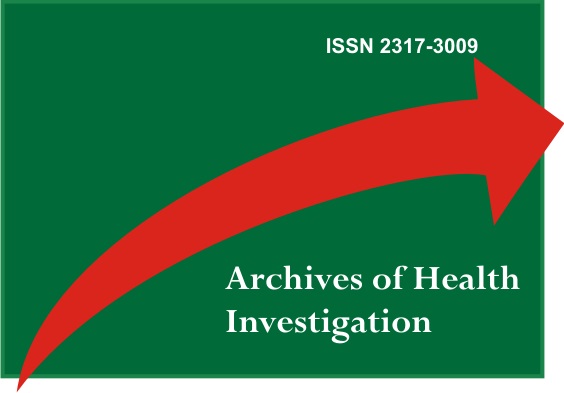Is there a relationship between the prevalence of temporomandibular joint disorder and the phase of the during graduation?
DOI:
https://doi.org/10.21270/archi.v10i6.5021Keywords:
Temporomandibular Joint, Facial Pain, Temporomandibular Joint Dysfunction Syndrome, Temporomandibular Joint DisordersAbstract
Introduction: Craniomandibular complex disorders are characterized by musculoskeletal disorders that are closely linked to their difficult diagnosis, due to the multifactorial etiology of temporomandibular joint disorder. Objective: To investigate the possible relationship between the prevalence of symptoms of temporomandibular joint disorder in university students and the duration of the course, according to the variables of degree of dysfunction, enrolled period, gender and age. Material and method: The study consisted of 182 students, as volunteers, from the second to the tenth period, regularly enrolled in the 2nd semester of the Dentistry course, in 2019, at a private university in São José do Rio Preto- SP, Brazil. The questionnaire used was proposed by the American Academy of Orofacial Pain, containing ten questions with objective yes/no answers, about the most frequent symptoms of orofacial pain and temporomandibular joint disorder. The Fonseca Anamnesis Index was used to assess the degree of dysfunction of the students, with a value of 0 or 10 points per question, totaling the sum of up to 100 points. Results: The volunteers most affected by the symptoms were those present in the eighth and tenth period of the course, with a lower prevalence in the members of the fourth period. It was found that the female gender had a higher prevalence of symptoms when compared to the male, aged 18 to 47 years old. Conclusion: The prevalence of temporomandibular joint disorder symptoms in university students seems to be related to the time of the course, as students enrolled in the final stages of the course showed a greater prevalence of temporomandibular joint disorder.
Downloads
References
Donnarumma MDC, Muzilli CA, Ferreira C, Nemr K. Disfunções Temporomandibulares: sinais, sintomas e abordagem multidisciplinar. Rev CEFAC. 2010; 12(5):788-94.
Pereira KNF, Andrade LLS, Costa MLG, Portal TF. Sinais e sintomas de pacientes com disfunção temporomandibular. Rev CEFAC. 2005;7(2):221-28.
Alves-Rezende MCR, Silva JS, Soares BMS, Bertoz FA, Oliveira DTN, Claro APRA. Estudo da prevalência de sintomatologia temporomandibular em universitários brasileiros de odontologia. Rev Odontol Araçatuba. 2009;30(1):9-14.
Bezerra BPN, Ribeiro AIAM, Farias ABL, Farias ABL, Fontes LBC, Nascimento SR, et al. Prevalência da disfunção temporomandibular e de diferentes níveis de ansiedade em estudantes universitários. Rev DOR. 2012;13(3):235-42.
Goyatá FR, Taira NV, Almeida S, Silva DM, Taira CV. Avaiação de sinais e sintomas de disfunção temporomabndibular entre acadêmicos do curso de Odontologia da Universidade Severino Sombra, Vassouras-RJ. Int J Dent. 2010;9(4):181-86.
Figueiredo VMG, Cavalcanti AL, Farias ABL, Nascimento SR. Prevalência de sinais, sintomas e fatores associados em portadores de disfunção temporomandibular. Acta Sci Health Sci. 2009;31(2):159-63.
Portinho CP, Collares MVM, Faller GJ, Fraga MM, Pinto RA. Perfil dos pacientes com disfunção temporomandibular. ACM arq catarin med. 2012;41(1):95-9.
Ferreira CLP, Da Silva MAMR, Felício CM. Sinais e sintomas de desordem temporomandibular em mulheres e homens. CoDAS. 2016;28(1):17-21.
Carrara SV, Conti PCR, Barbosa JS. Termo do 1º Consenso em Disfunção Temporomandibular e Dor Orofacial. Dental Press J Orthod. 2010;15(3):114-20.
Daher CRM, Cunha LF, Ferreira APL, Souza AISO, Rêgo TAM, Araújo MGR, et al. Limiar de dor, qualidade de sono e níveis de ansiedade em indivíduos com disfunção temporomandibular. Rev CEFAC. 2018;20(4): 450-58.
Sena MF, De Mesquita KSF, Santos FRR, Silva FWGP, Serrano KVD. Prevalência de disfunção temporomandibular em crianças e adolescentes. Rev Paul Pedriatr. 2013;31(4): 538-45.
Minghelli B, Cardoso I, Porfírio M, Gonçalves R, Cascalheiro S, Barreto V, et al. Prevalence of temporomandibular disorder in children and adolescents from public schools in southern Portugal. N Am J Med Sci. 2014;6(3):126-32.
Deng YM, Fu MK, Hägg U. Prevalence of temporomandibular joint dysfunction (TMJD) in Chinese children and adolescents. A cross-sectional epidemiological study. Eur J Orthod. 1995;17(4):305-9.
Winocur E, Gavish A, Finkelshtein T, Halachmi M, Gazit E. Oral habits among adolescent girls and their association with symptoms of temporomandibular dis¬orders. J Oral Rehabil. 2001;28(7):624-9.
Paulino MR, Moreira VG, Lemos GA, Da Silva PLP, Bonan PRF, Batista AUD. Prevalência de sinais e sintomas de disfunção temporomandibular em estudantes pré-vestibulandos: associação de fatores emocionais, hábitos parafuncionais e impacto na qualidade de vida. Ciên Saúde Colet. 2018; 23(1):173-86.
Schmitter M, Rammelsberg P, Hassel A. The preva¬lence of signs and symptoms of temporomandibular disorders in very old subjects. J Oral Rehabil. 2005;32(7):467-73.
Cavalcanti MOA, Lima CMC, Lima JMC, Gomes I, Gordim JR. Estud Interdiscipl Envelhec. 2015;20(2):551-66.
Fernandes AUR, Garcia AR, Zuim PRJ, Cunha LDP, Marchiori AV. Desordem temporomandibular e ansiedade em graduandos de odontologia. Cien Odontol Bras. 2007;10(1):70-7.
Oliveira KL, Almeida GA, Lelis ER, Tavares M, Fernandes Neto AJ. Temporomandibular disorder and anxiety, quality of sleep, and quality of life in nursing profissionals. Braz Oral Res. 2015;29(1):1-7.
Medeiros SP, Batista AUD, Forte FDS. Prevalência de sintomas de disfunção temporomandibular e hábitos parafuncionais em estudantes universitários. Rev Gaúch Odontol. 201;59(2):201-8.
Oliveira AS, Dias EM, Contato RG, Berzin F. Prevalence study of signs and symptoms of temporomandibular disorder in Brazilian college students. Braz Oral Res. 2006;20(1):3-7.
Scheffer CAC, Frigo LF. Relação da incidência de sintomas de disfunção temporomandibular com a qualidade de vida em estudantes universitários. Fisioter Bras. 2012;13(6):446-51.
Chaves TC, Oliveira AS, Grossi DB. Principais instrumentos para avaliação da disfunção temporomandibular; parte I: índices e questionários; uma contribuição para a prática clínica e de pesquisa. Fisioter Pesqui. 2008; 15(1):92-100.


